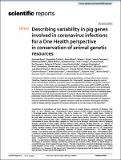Por favor, use este identificador para citar o enlazar a este item:
http://hdl.handle.net/10261/284012COMPARTIR / EXPORTAR:
 SHARE SHARE
 CORE
BASE CORE
BASE
|
|
| Visualizar otros formatos: MARC | Dublin Core | RDF | ORE | MODS | METS | DIDL | DATACITE | |

| Título: | Describing variability in pig genes involved in coronavirus infections for a One Health perspective in conservation of animal genetic resources |
Autor: | Bovo, Samuele CSIC; Schiavo, Giuseppina; Ribani, Anisa; Utzeri, Valerio J.; Taurisano, Valeria; Ballan, Mohamad; Muñoz, María; Alves, Estefania; Araújo, José Pedro; Bozzi, Riccardo; Charneca, Rui; Di Palma, Federica; Djurkin Kušec, Ivona; Etherington, Graham; Fernández, Ana Isabel; Suárez García, Fabián CSIC ORCID ; García Casco, Juan María; Karolyi, Danijel; Gallo, Maurizio; Martins, José Manuel; Mercat, Marie-José; Núñez, Yolanda; Quintanilla, Raquel; Radović, Čedomir; Razmaite, Violeta; Riquet, Juliette; Savić, Radomir; Škrlep, Martin; Usai, Graziano; Zimmer, Christoph; Óvilo Martín, Cristina; Fontanesi, Luca | Palabras clave: | Dipeptidyl peptidase IV Virus receptor Microsomal aminopeptidase Serine proteinase |
Fecha de publicación: | 9-feb-2021 | Editor: | Nature Publishing Group | Citación: | Scientific Reports 11(1): 3359 (2021) | Resumen: | Coronaviruses silently circulate in human and animal populations, causing mild to severe diseases. Therefore, livestock are important components of a "One Health" perspective aimed to control these viral infections. However, at present there is no example that considers pig genetic resources in this context. In this study, we investigated the variability of four genes (ACE2, ANPEP and DPP4 encoding for host receptors of the viral spike proteins and TMPRSS2 encoding for a host proteinase) in 23 European (19 autochthonous and three commercial breeds and one wild boar population) and two Asian Sus scrofa populations. A total of 2229 variants were identified in the four candidate genes: 26% of them were not previously described; 29 variants affected the protein sequence and might potentially interact with the infection mechanisms. The results coming from this work are a first step towards a "One Health" perspective that should consider conservation programs of pig genetic resources with twofold objectives: (i) genetic resources could be reservoirs of host gene variability useful to design selection programs to increase resistance to coronaviruses; (ii) the described variability in genes involved in coronavirus infections across many different pig populations might be part of a risk assessment including pig genetic resources. | Descripción: | 14 Pág. Departamento de Mejora Genética Animal | Versión del editor: | https://doi.org/10.1038/s41598-021-82956-0 | URI: | http://hdl.handle.net/10261/284012 | DOI: | 10.1038/s41598-021-82956-0 | ISSN: | 2045-2322 |
| Aparece en las colecciones: | (INIA) Artículos |
Ficheros en este ítem:
| Fichero | Descripción | Tamaño | Formato | |
|---|---|---|---|---|
| Describing-variability-in-pig-genes-involved-in-coronavirus.pdf | artículo | 5 MB | Adobe PDF |  Visualizar/Abrir |
CORE Recommender
PubMed Central
Citations
7
checked on 12-abr-2024
SCOPUSTM
Citations
8
checked on 23-abr-2024
WEB OF SCIENCETM
Citations
8
checked on 27-feb-2024
Page view(s)
48
checked on 24-abr-2024
Download(s)
23
checked on 24-abr-2024

